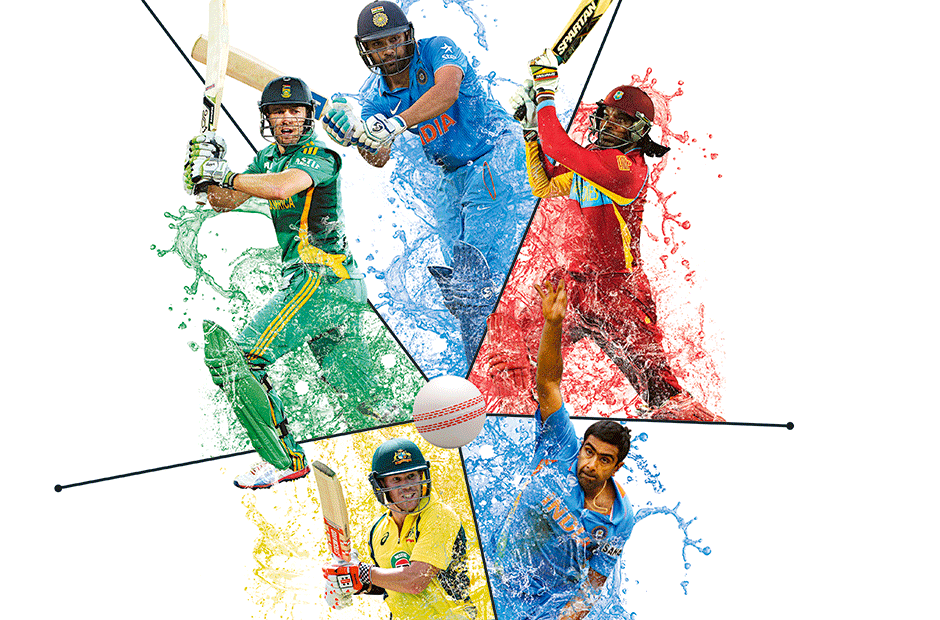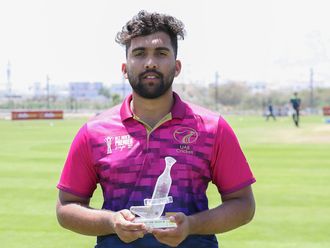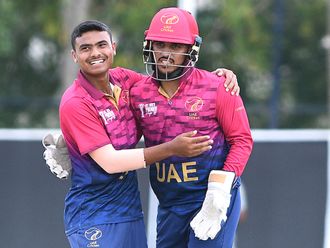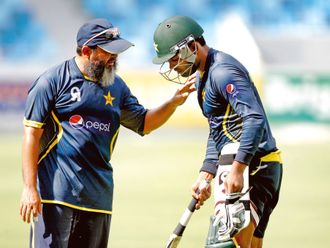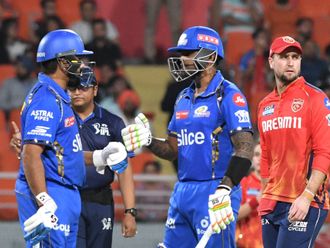India: Rohit Sharma, right-handed batsman
It was the quarter-final of the 2015 World Cup. Forty overs had been bowled and Rohit Sharma was visibly tired having played a superb innings, which had put India in a commanding position. The job, however, was not yet done. There is a major difference between 280 and 300 plus and Sharma knew it well. A push to midwicket by Sharma and M.S. Dhoni, the non-striker, was off like lightning. The captain had pushed his premier batsman and Sharma’s expression said a thousand words. Wiping off the sweat, he applauded his captain and took guard yet again. It said a lot about his mindset and also that of the team.
The next few overs saw mayhem. Sharma just exploded and pushed the game three gears up — six over extra cover, over midwicket and straight down the ground. Bangladesh was suddenly being toyed with. Failing to make an adjustment in the mind, for the longest time Sharma had remained an enigma.
Batting comes easy to him and may be that was one of the reasons he did not understand the value of being out there in the middle for long. That extra second he has to play each shot was the cause of his downfall. Once this adjustment was made (after he was dropped from the team), Sharma realised he had to come good to make a name for himself. Failing to make the cut in the 2011 World Cup was a blow and that made sure he would do all he needed to stage a comeback.
Captaincy in the IPL helped, for it allowed him to take more responsibility. And 2013 onwards it has been a different Sharma. Two ODI double hundreds and many more match-winning innings in the shortest format mean Rohit Gurunath Sharma is clearly India’s go-to man in the World T20.
West Indies: Chris Gayle, right-handed batsman
The last batsman you would ordinarily imagine to be playing 100 Test matches in this era of hyper commercialism is Chris Henry Gayle. Universally acclaimed as the most destructive T20 batsman, Gayle, almost without anyone realising it, has also played 100 Tests, making a grand entry into an exclusive club reserved for the very best in the game. The best known West Indian cricketer in the post-Brian Lara era, Gayle, many may have forgotten, has a triple hundred in Test cricket.
Gayle is the quintessential example of the modern-day cricketer — one who is perpetually torn between club and country loyalties. Should he opt to play the IPL or the Big Bash, or should he remain loyal to Royal Challengers Bangalore ignoring his commitment to the West Indies team?
In an interview to me during the World T20 in Sri Lanka in October 2012, Gayle made it clear he enjoys playing T20 the most. It is natural because this is one format where he can actually dominate. Success breeds confidence and understandably he prefers T20 to Test cricket.
Finally, I must reveal something about Gayle, which most readers may not perhaps know. For someone who hits the ball a 100 plus miles, power is something that comes naturally. Blessed with a fantastic physique, Gayle can create quite an impression at a face-to-face meeting. However, the moment you shake hands you wonder what on earth is going on? Unlike a Shahid Afridi, for example, whose palms are as hard as metal, Gayle’s are as soft as a pillow! Bowlers needn’t read too much into it though, for these hands can give them nightmares during the World T20.
Australia: David Warner, right-handed batsman
He is one of the most consistent batsmen in the world today. Be it T20, ODIs or even Test cricket, David Warner at the top of the order inevitably gives Australia that extra edge. And what a story it’s been.
It was when he was left out of the squad in 2013 that Warner realised something was amiss — that he was not indispensable and his legacy was in doubt. As he has himself said on a number of occasions thereafter, the question was should he walk away from cricket as the game’s bad boy or does he want to play for a decade and more and go out as a legend? The answer was obvious.
Just around then he had gotten close to Candice Falzon, former iron woman, who has now given birth to Warner’s two daughters. Inspired to see Falzon train early in the morning, Warner started on a regime that changed the man forever. Getting things right in his head, he finally started doing justice to his immense talent.
Loads of runs in the Ashes series that followed — a streak that continued into South Africa — Warner was soon the star player for Australia. So what really changed? Is it more to do with his mindset? Is he confident of handling spin in subcontinental conditions and has the IPL helped? It is a combination of all of the above. Anyone who has seen Warner bat recently will agree he is at ease playing spin. No more uncertain footwork and with the determination to take the attack to the spinners, Warner has now learnt to enjoy batting in the subcontinent, making him a potential star of the World T20.
South Africa: A.B. de Villiers, right-handed batsman
One simple stat is enough to show how good A.B. de Villiers and his team are — they are a rare bunch that thrashed India on home ground in October-November 2015 in both ODIs and T20s. This is all the more important because in India most teams start as underdogs in the shorter formats with Dhoni and his men expected to triumph in familiar territory. That’s where ABD can be at his most dangerous.
Easily the most talented cricketer in the world at the moment, we know what he is capable of. And here one mustn’t ignore his fielding prowess, which is second to none. When he is at his destructive best, there is no bowler who can stop him. From quality cricket strokes to imperious improvisations, he has it all. A swivel to the offside and all of a sudden we see the ball sail over midwicket or fine leg for six. Most importantly, he is amazingly consistent and that’s what makes him the most potent T20 batsman. Is there a recipe to contain him? Can the opponents come up with a plan to keep ABD in check through the tournament or is it too much to ask for?
Perhaps the answer to this question will determine how far South Africa will progress in the tournament. ABD too will want to shed off the underachievers’ tag. Despite having the best team, South Africa choked yet again in the 2015 World Cup semi-final against New Zealand in Auckland. For the record they have never won a World Cup. With ABD at his best, this is their opportunity, something De Villiers and his teammates will not want to let go easily.
India: Ravichandran Ashwin, spin bowler
Ravichandran Ashwin is the world’s leading spinner, evident from his top ten ranking in all three formats of the sport. After a stupendous World Cup 2015, which had given him enormous confidence, he now fancies winning matches in all conditions.
Bowling at the death has been India’s biggest problem in the past five years and the one central reason has been the fast bowlers’ inability to contain runs. That’s where Ashwin comes in. With a number of variations in his kitty, it is essential for India that Ashwin steps up to doing what Dhoni and millions of Indian fans want him to do — be India’s premier bowler in the most difficult circumstances against teams like Pakistan and Australia. In subcontinental conditions, he is already wrecker-in-chief.
Dropped for being inconsistent in 2014, Ashwin has worked on his bowling in the last year and a half. And in the recent T20 series against Australia it was a pleasant surprise to see him toss the ball up and give it a lot many more revolutions than he was doing for a while. Rather than bowling flat, he had turned the wheel to being the conventional off-spinner all of us wanted him to be.
With the ball coming from a reasonable height and the ball that goes the other way very much in his weaponry, Ashwin is racing to wickets against quality opposition. The temporary dip in batting form notwithstanding, India will be looking to him in critical moments.


